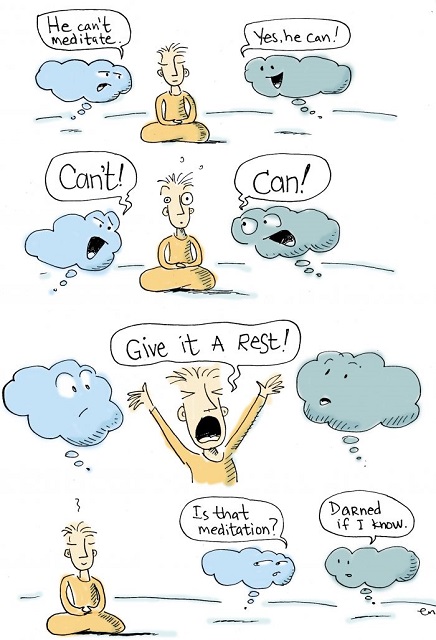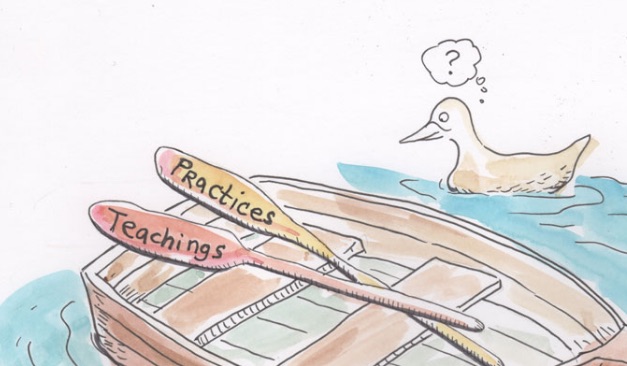A member of the Wisdom Heart community writes:
“I’ve stopped and started a meditation practice several times. While I’m sure I haven’t given it a fair trial, when I have done it, I haven’t gotten anything out of it…unlike exercising, for example. After a 25-minute jog, I feel better. But I don’t feel anything after a meditation session.
I have stress and anxiety that I’d like to deal with better, and meditation has great reviews when it comes to stress and anxiety. I’m willing to commit to 10 minutes a day, and short deep breath breaks during the day, but I can’t see going any further until I see at least a glimpse of benefit from it.”
~
You’d like to experience the benefits of meditation? Me too!
Given that we’re in the same boat, I have some good news and some bad news.
The good news is: You can learn how to meditate and experience the benefits.
The bad news is: You’re never done learning how to meditate, and the benefits will come, but not in the way you imagine.
The problem with the good news is that it sets you up for frustration.
You can read about meditation everywhere. There’s daily research about all the amazing benefits. You can listen to teachers and get inspired. You want what they promise. You want the benefits.
So, what’s the problem?
Reading about meditation is like reading a menu. As you read the menu, you create mental representations of the different items. You “taste” the food in your mind. When you read a description that generates a particularly tasty mental experience, you stop and point at the menu, saying, “That sounds good. I’ll have that!”
Then the meal arrives.
No matter what you’ve imagined, the actual meal isn’t what you thought it would be. You may be disappointed, or you may ecstatic.
Either way, you’re experiencing something that is more primary than your ideas about the meal. Your ideas are secondary representations of the meal. They’re not the meal; they just got you to order the meal. Now, you’re chewing on the real thing.
It’s the same with meditation.
Reading books and listening to teachings generates mental representations of what meditation could be like. When you read a text or hear a teaching that generates a particularly pleasant mental experience, you stop and say, “That sounds good. I’ll have that!”
The inspiring idea gets you to start practicing.
You’d never start if you didn’t have an idea about the benefits.
So reading, listening, and imagining benefits are all useful. They provide motivation. They get you to sit down and start the practice.
That’s when it gets challenging.
Because no matter how carefully you’ve constructed a mental image of meditation—it will never match the actual experience of this moment. This moment is what it is…regardless of your ideas and expectations.

.
This is true at restaurants and on the meditation cushion. As you practice, this contrast becomes more and more obvious. How you meet this contrast is by learning how to meditate. And how you meet this contrast is what will bring you benefits that you cannot imagine.
Notice the word…how.
This word is the key to embracing the bad news about meditation that: You’re never done learning how to meditate.
The benefits will come—but not in the way you imagine.
Any and all ideas about what meditation is (or even can be) are then seen for what they are—thoughts.
Thoughts aren’t wrong or bad. Thoughts are secondary.
These secondary mental constructions are useful as motivation to practice. They bring you to the cushion, but then it’s time turn from the mind’s fascination with secondary phenomenon to that which is primary.
So, what is primary? The direct experience of this moment is primary.
While thoughts about benefits may bring you to the cushion, holding on to those thoughts will drive you away.
Thoughts about peace of mind, awakening, or freedom can bring you to the practice. But thinking these thoughts won’t sustain the practice. That’s not a problem you solve by more thinking, or even different thinking. In fact, it’s not a problem at all. It’s just a realization of the limits of thought.
Once you’re on the cushion, thinking about how you would like this moment to be is a distraction.
Comparing your experience of this moment to your expectations will always end in disappointment. Still, you don’t have to push thoughts away, as that only entangles you in more thinking.
So, what to do?
Honor thought for what it can do.
Once you’re on the cushion, thought has fulfilled its purpose. Now it’s time to let go of assessing, measuring, and evaluating whether or not you’re getting what you thought you wanted. It’s time to open up to what is primary—the experience of this moment.
This opening up is a practice.
You don’t push thoughts about meditation away. Where could they go, anyway?
Instead, you look deeply and see—thoughts have fulfilled their purpose. When you see this, your attention naturally rests more and more in what is primary.
With a breath, a new revelation dawns.
A new vista emerges—a new awareness of the meaning and benefits of meditation.
Feeling this, you’ll smile. Because what you’ll discover—in this moment—is something you couldn’t have ever imagined.
.
~
Author: Eric Klein
Image: Author’s original illustrations
Editor: Yoli Ramazzina



Read 0 comments and reply